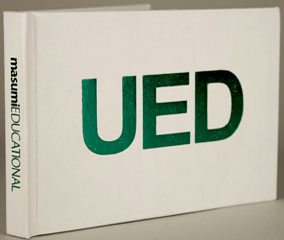 UED The Pocket Masumi Educational Uncertain English Dictionary By Masumi Shibata, Editor in Chief Rochester, New York: Preacher's Biscuits Books, 2008. 6.25 x 4.75"; 63 pages. Offset printed. Case bound in white boards with embossed metallic green title on front cover and titles in green on spine. Preacher Biscuit's Books: "Produced in collaboration with masumiEDUCATIONAL, UED is the accepted authority on the evolution of the English language. It visually creates and defines a wide range of expressions every international English speaker wanted but previously thought indefinable. UED covers words from across the emotional spectrum while simultaneously providing graphically poetic interpretations. It also offers space for hand writing practice and includes mE's International Phonetic Alphabet for rehearsing vocal pronunciation." Rebecca Kish, Center for Book Arts, blog: “UED stands for Uncertain English Dictionary. Shibata’s creative vision not only incorporates design and clean and sturdy case bound technique, but the content is crucial in its necessity to form a connection through a universal symptom of disconnect. "The UED is a gathering of cultural diversifications of the English language and seeks to inform the reader of a growing acceptance of an umbrella of linguistic interpretations- a culture not created from the deviation of one root, but a celebration of differences. Gathered and prepared for a new articulation, the UED provides space in which to practice writing out new understandings, as well as pronunciation of words. "The Uncertain English Dictionary varies from a standard index in that it is not the consensus of a consortium of authorities, but the expressed opinion of one individual. Shibata makes no excuses for this primary authority, instead seeming to offer a window into his language, with hopes that the wide reach of non-verbal inferences will be apparent to the viewer. Below the title is both the assertion of Masumi Shibata as Editor in Chief and the logo of MasumiEducational, the branding under which Shibata’s other efforts fall. "The graphic design component is also significant. Shibata uses the clean and non-threatening efficiency of Helvetica, yet skews the writing by clean cutting it in half and re-assembling stalks of stems, bowls, arms and legs. The result is a hard to identify combination of fonted flurry, negating the simplicity and asserting the disconnect that the viewer/reader must work through to extract meaning. The definition, however, is expressed in clear and simple language. Shibata may be playing with the role of graphics in our interpretation of language, or merely leading us through a process that shows us the patience of decoding symbols, leading us through mental exercise."
|